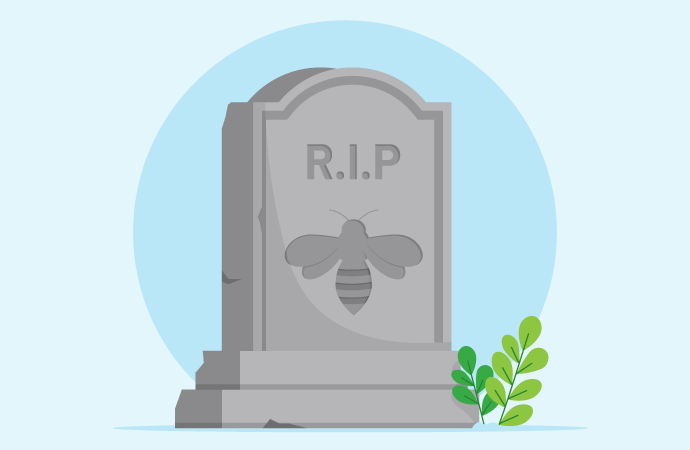For millions of years, bees have been hard at work carrying pollen from one flower to another. These small but mighty creatures are responsible for helping sustain all life on the planet, thanks to their vital role in local ecosystems.
And yet, despite their importance, for almost two decades, beekeepers have been raising the alarm about declining bee populations. So, what would the extinction of bees mean for humans, plants, and the environment?
The importance of bees in the ecosystem
We may only think of bees as providers of honey, but they are also critical to our food production systems. Bees are nature’s most important pollinators, which means they pick up the pollen of flowers and spread it around, enabling plants to reproduce. This is particularly significant for food crops such as fruits, nuts, and vegetables.
In fact, almost 75% of crops cultivated for human consumption across the world depend on bees for pollination, including both honeybees raised for farming and over 20,000 species of wild bee. In the US alone, there are nearly 3 million colonies with tens of billions of bees – which pollinate around $15 billion worth of crops every year, from zucchinis to almonds.
Not only are they life-sustaining, but they are economic drivers, supporting agriculture around the world. So much so that you can even donate bees to households in the developing world, to not only provide an immediate income through honey and beeswax, but to help support their crops through pollination.
This makes bees essential for global food security, as well as an important source of income for many rural livelihoods.
The reasons behind the decline of bee populations
Sadly, the bee population is facing increasing challenges, largely due to human behavior. In 2022, honeybee hives in the US saw their second highest death rate on record, with beekeepers losing almost half of their managed colonies.
There are several factors contributing to the decline of both honeybees and wild bees, including:
- Climate change. Significant weather changes, such as unusually warm weather, can bring bees out of their normal seasonal routine.
- Intensive farming practices. The loss of natural bee habitats reduces access to food, while pesticides weaken their immune systems and make them vulnerable to disease.
- Air pollution. Bees’ ability to locate food may be affected by air pollutants interacting with the scent molecules released by plants.
- Parasites. European honeybees have been particularly impacted by a harmful parasite known as varroa destructor, which can transmit viruses and cause entire bee colonies to collapse.
The impact of bee extinction on the global food supply
We don’t want to alarm you, but if bees become extinct, the effects will be felt throughout major ecosystems. Many plants can only be pollinated by bees and would most likely die out unless humans are able to come up with a technological solution. This, in turn, would impact the wider habitats and food webs these plants are part of – triggering additional declines or extinctions.
When it comes to agriculture, the loss of bees would significantly alter what humans eat, since many fruits and vegetables could not be cultivated cheaply and on a mass scale as they are now. The result would be a dramatic decline in the availability and diversity of the types of fresh produce we’re accustomed to. Hand pollination may be an option for certain crops but is costly and labor-intensive – pushing up consumer prices.
Yet while it may be farewell to avocado on toast and almond lattes, the silver lining is that the majority of human food still comes from cereal grains which are wind-pollinated, making it possible to avert global famine.
Conservation efforts and technological responses: potential solutions
Governments and decision-making bodies worldwide have recognised the serious threat posed to the existence of bees. In 2018, the European Union upheld a partial ban on a number of insecticides, and the United Nations’ post-2020 biodiversity framework calls for a reduction of pesticides by at least two-thirds by 2030. The UN has also declared May 20 World Bee Day to highlight the importance of protecting bees and their habitats.
Meanwhile, tech startups like Beewise are developing technologies to help beekeepers manage their bee populations more effectively. For example, “smart beehives” use AI to monitor temperature, humidity, and bee behavior – alerting the beekeeper if there is a problem in their hives.

There’s also a drive for technological solutions that can ensure pollination even when there is a shortage of local bees. Robotic bees are already in commercial use, using vibrations to mimic the wing action of a bee, triggering the release of pollen.
The role of urban beekeeping and community Initiatives
With growing public awareness around declining bee populations, recent years have seen a surge in urban beekeeping such as backyard and rooftop beehives.
However, contrary to popular belief, experts say that these may be doing more harm than good – by making it harder for wild bees to find food. Studies have shown that areas with the largest increase in domesticated honeybees actually had the lowest wild bee populations.
So how can we play our part in helping save the bees? The answer is to support the beekeeping industry and make your garden more friendly to wild bees. Here are some actions you can take:
- Buy honey and other bee products from local beekeepers.
- Plant native or nectar-bearing flowers that bloom at different times of the year.
- Leave small areas of the yard for wildflowers, weeds, and fallen leaves.
- Preserve old meadows and cut their grass only after flowers have finished blooming.
- Only use pesticides that don’t harm bees, and spray early in the morning or late at night.


